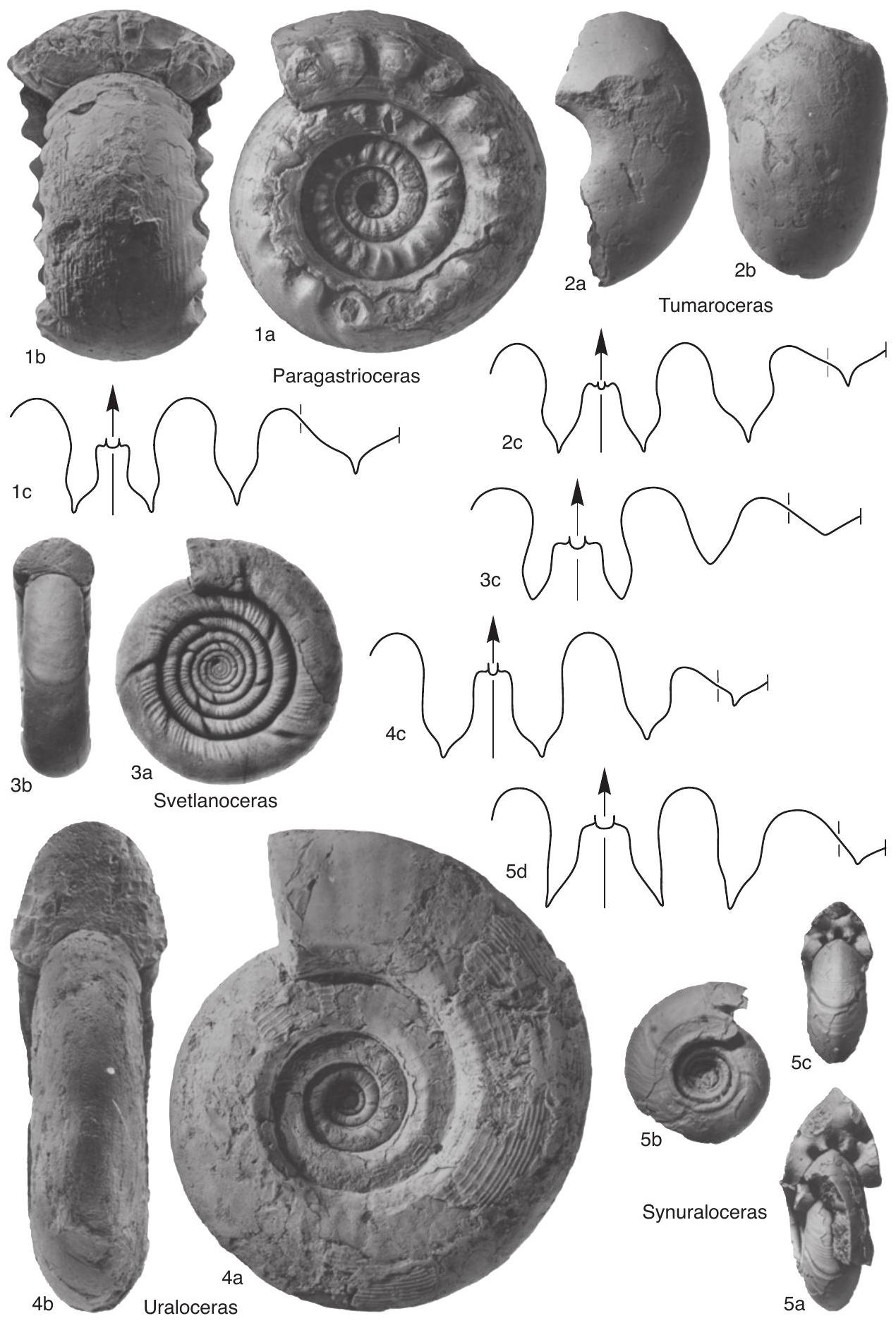Welcome to the Treatise on Invertebrate Paleontology!
Please enter a genera name to retrieve more information.

Paragastrioceras
Classification
Phylum:
Mollusca
Class:
Cephalopoda
Subclass:
Ammonoidea
Order:
Goniatitida
Suborder:
Goniatitina
Superfamily:
Neoicoceratoidea
Family:
Paragastrioceratidae
Subfamily:
Paragastrioceratinae
Formal Genus Name and Reference:
Paragastrioceras CHERNOV, 1907, p. 288
Type Species:
Goniatites Jossae de Verneuil, 1845, p. 371, SD RUZHENTSEV, 1936b, p. 1079
Images
(Click to enlarge in a new window)
Fig. 104, 1 a-c. *P. jossae jossae (de Verneuil), Baigendzhinian, Southern Urals, a-b, X 0.67, c, diameter at 70 mm (Ruzhentsev, 1956b).
Synonyms
Girtyites; Eotumaroceras; Baraioceras
Geographic Distribution
Kazakhstan (Southern Urals), Russia (Urals, Verkhoian, Ochtsko-Kolymskiy Massif), Tajikistan (?Darvas), Italy (Carnic Alps), Slovenia, Canada (Arctic Archipelago, Yukon), Western Australia, China (Nei Mongol)
Age Range
Beginning Stage in Treatise Usage:
Cisuralian (Asselian)
Beginning International Stage:
Asselian
Fraction Up In Beginning Stage:
0
Beginning Date:
298.89
Ending Stage in Treatise Usage:
Cisuralian (Kungurian)
Ending International Stage:
Kungurian
Fraction Up In Ending Stage:
100
Ending Date:
274.37
Description
Conch large, thickly subdiscoidal (W/D, commonly 0.4–0.6) with wide umbilicus (U/D, greater than one-third) and depressed whorls (H/W, commonly two-thirds). Pronounced nodes or laterally attenuate ribs generally retained on umbilical shoulders to maturity. Strong longitudinal strigae and weaker convex growth lines produce reticulate sculpture. Prongs of ventral lobe characteristically much narrower than lateral lobe; both prongs and lateral lobe (V 1 and L) are attenuated adapically and constricted adorally. Thirty named species. [A fully mature aperture has been observed in this genus, rarely, to comprise long paired ventral salients bisected by a deep hyponomic sinus.]
References
Museum or Author Information
Classification
Phylum:
Mollusca
Class:
Cephalopoda
Subclass:
Ammonoidea
Order:
Goniatitida
Suborder:
Goniatitina
Superfamily:
Neoicoceratoidea
Family:
Paragastrioceratidae
Subfamily:
Paragastrioceratinae
Formal Genus Name and Reference:
Paragastrioceras CHERNOV, 1907, p. 288
Type Species:
Goniatites Jossae de Verneuil, 1845, p. 371, SD RUZHENTSEV, 1936b, p. 1079
Images
(Click to enlarge in a new window)
Fig. 104, 1 a-c. *P. jossae jossae (de Verneuil), Baigendzhinian, Southern Urals, a-b, X 0.67, c, diameter at 70 mm (Ruzhentsev, 1956b).
Synonyms
Girtyites; Eotumaroceras; Baraioceras
Geographic Distribution
Kazakhstan (Southern Urals), Russia (Urals, Verkhoian, Ochtsko-Kolymskiy Massif), Tajikistan (?Darvas), Italy (Carnic Alps), Slovenia, Canada (Arctic Archipelago, Yukon), Western Australia, China (Nei Mongol)
Age Range
Beginning Stage in Treatise Usage:
Cisuralian (Asselian)
Beginning International Stage:
Asselian
Fraction Up In Beginning Stage:
0
Beginning Date:
298.89
Ending Stage in Treatise Usage:
Cisuralian (Kungurian)
Ending International Stage:
Kungurian
Fraction Up In Ending Stage:
100
Ending Date:
274.37
Description
Conch large, thickly subdiscoidal (W/D, commonly 0.4–0.6) with wide umbilicus (U/D, greater than one-third) and depressed whorls (H/W, commonly two-thirds). Pronounced nodes or laterally attenuate ribs generally retained on umbilical shoulders to maturity. Strong longitudinal strigae and weaker convex growth lines produce reticulate sculpture. Prongs of ventral lobe characteristically much narrower than lateral lobe; both prongs and lateral lobe (V 1 and L) are attenuated adapically and constricted adorally. Thirty named species. [A fully mature aperture has been observed in this genus, rarely, to comprise long paired ventral salients bisected by a deep hyponomic sinus.]
